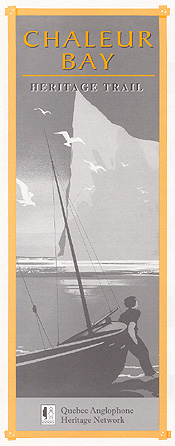
The cod banks of the Gaspé coast were crowded waters on the fringe of an unknown land.
Long before Jacques Cartier claimed Quebec for France, European fishermen knew some of the best cod-fishing grounds in the Atlantic lay in a shallow, bay off the south coast of the Gaspé Peninsula. Basque, Breton and Norman crews would dress their haul on the beaches then set sail before freeze-up in the fall. Finding the sea warm here in mid-July, Cartier gave the bay its name, Chaleur, the French term for heat. Cheap, plentiful and nutritious, Gaspé dry salt cod was a food staple in southern Europe for.
For the French crews who came here, the yearly voyage was filled with toilsome danger. In addition to the perils of crossing the Atlantic and the drudgery of cod-fishing, rivalry between France and England exposed them to attack.
Many historic towns and villages along this Heritage Trail began as summer fishing stations under the French regime. Lacking fortifications, the fledgling colonies were easy targets for English warships. Percé was sacked and burned in 1690; settlements at Gaspé Bay, Grande-Rivière and Pabos demolished in the 1750s.
Contact with Europeans also proved deadly for Micmac people. Zealous missionaries, disease, firearms, alcohol and dependence on trade goods destroyed their old way of life.
Not till the arrival of a cod merchant from Britain’s Channel Islands would year-round communities on the Gaspé coast take hold. The fishing company founded in the 1760s by Charles Robin lured Micmacs, Acadians and Jersey Islanders into the trade. Boatloads of Loyalist and British pioneers followed, bringing hopes for a better life.
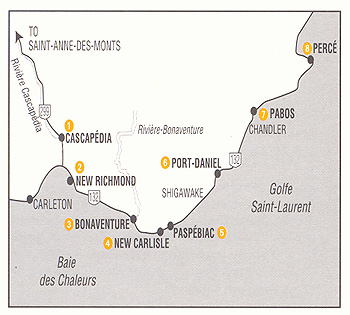 GETTING THERE
GETTING THERE
This Heritage Trail leads to historic settlements and points of interest on Chaleur Bay, from the mouth of the Grand Cascapedia River to the resort town of Percé. Route 132 is a stretch of scenic coastal highway that can be reached from Saint-Anne des Monts by driving south from the St. Lawrence River across the peninsula on Route 299.
CASCAPEDIA VILLAGE (pop. 700)
The Cascapedia River rises in the Shick Shock Mountains, flowing 139 kilometres to the sea. It was a traditional thoroughfare for Micmacs, who named the territory Gespegegiag.
Today’s inhabitants also count settlers from Ireland, Scotland and Acadia among their ancestors.
Salmon fishing has been a popular sport since the 1870s when local families began opening their homes to wealthy anglers. Generations of Cascapedia villagers have worked as guides, cooks and servants in their exclusive private camps. Sport-fishing remains the lifeblood of the community.
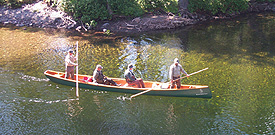 The first high-profile visitors were Princess Louise, Queen Victoria’s fourth daughter and her husband, a governor general of Canada. During the couple’s first trip to Cascapedia in 1874, they stayed at the Nathaniel Woodman House (1837), known as “Red Camp”. The red house and barn buildings still stand eight kilometres north of the village on Route 299.
The first high-profile visitors were Princess Louise, Queen Victoria’s fourth daughter and her husband, a governor general of Canada. During the couple’s first trip to Cascapedia in 1874, they stayed at the Nathaniel Woodman House (1837), known as “Red Camp”. The red house and barn buildings still stand eight kilometres north of the village on Route 299.
Over the years the guest list has included Canadian prime ministers, American presidents and famous entertainers. Hockey great Bobby Orr has adopted the river as his own. The Cascapedia River Museum, located in the old Campbell Brothers general store, tells about fishing lore and local angling culture.
275 Route 299
Cascapedia - St Jules
Québec G0C 1T0 Canada (418) 392-5079
 NEW RICHMOND (pop. 3,900)
NEW RICHMOND (pop. 3,900)
The commercial hub of Chaleur Bay rests on a broad valley of land hemmed between two branches of the Cascapedia and the sea. Acadian families were the first Europeans to live here. They were joined in 1784 by large numbers of Loyalist settlers. Their presence and the subsequent arrival of Scottish, Irish and Jersey immigrants made New Richmond a centre of English-speaking culture.
Be sure to visit the Gaspesian British Heritage Village, a major attraction featuring 24 historic buildings, antique machinery and guides dressed in period costume.
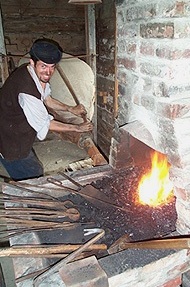 The site also houses a collection of genealogy archives and a reading room devoted to Gaspé’s Channel Island heritage.
The site also houses a collection of genealogy archives and a reading room devoted to Gaspé’s Channel Island heritage.
Unlike many other communities on this Trail, New Richmond developed as a mill town. A Scottish merchant named William Cuthbert built the first sawmill here in 1838 and later operated a shipyard at Duthie’s Point, now part of the Heritage Village.
Gaspesian British Heritage Village
351 Perron Blvd. West (418) 392-4487
Website: www.gaspesianvillage.com
Email: [email protected]
BONAVENTURE (pop. 2,920)
The Acadian town of Bonaventure was founded in 1760 by families escaping deportation from their homelands in Nova Scotia. Today about two-thirds of the population living on Chaleur Bay are Acadian.
Fearing that these French-speakers posed a threat to Britain’s North American colonies, England sent 10,000 Acadians into exile in 1755. Many moved to Louisiana, where their language and traditions survive in modern Cajun culture.
Some ran away to New Brunswick, where they lived briefly at the French garrison town of La Petite Rochelle on the Matapedia River. About a dozen families eventually settled at the mouth of the Bonaventure River. To learn more about Acadian culture and this tragic episode in Canada’s colonial past, visit the Acadian heritage museum.
Musée acadien du Québec
95, avenue Port Royal (418) 534-4000
Website: www.museeacadien.com
NEW CARLISLE (pop. 1,500)
Administrative seat of historic Bonaventure County, New Carlisle first took shape as a farming colony after Loyalists came to Chaleur Bay in 1784. In the 19th century, professional and merchant-class families established their homes here. Previously settled by Acadian farmers, the community later attracted a number of Scottish immigrants. It remains one of the few places on the coast where English can still be heard at town-hall meetings.
New Carlisle’s architectural heritage has been well-preserved. Several landmarks can be glimpsed from the Trail route, including the United Church (1820) at 137 G.D. Levesque Blvd. -- one of five local churches -- and Hamilton House (1852), now a museum at 115 Gerard-D.-Levesque Blvd. A guide to these and 17 other historic buildings is available from Town Hall.
A longtime government town, New Carlisle is also home to the Spec, Gaspé’s only English-language newspaper.
New Carlisle’s most famous native son was French-Canadian nationalist leader René Lévesque, founder of the Parti Québécois and premier of Quebec from 1976 to 1985. There is a plaque outside his boyhood home at 16 Mount Sorel Street.
Hamilton House: 115 Blvd. Gerard-D.-Levesque
(418) 752-2822
New Carlisle Town Hall, 138 Blvd. Gerard-D.-Levesque
(418) 752-3151
PASPÉBIAC BEACH
National Historic Site
In 1766, Jersey-born fish merchant Charles Robin recognized Paspébiac beach as a choice location for his dry-cod business. The coastline here features a large barachois, or triangular-shaped lagoon, perfect for small inshore rowboats.
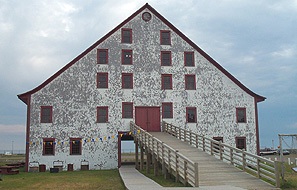 Paspébiac became North American headquarters for Robin’s commercial empire. It grew in the 1800s to include a chain of general stores and fishing stations along the Gaspé coast. A large house above the harbour built for the company’s general manager operates today as the Auberge du Parc inn.
Paspébiac became North American headquarters for Robin’s commercial empire. It grew in the 1800s to include a chain of general stores and fishing stations along the Gaspé coast. A large house above the harbour built for the company’s general manager operates today as the Auberge du Parc inn.
In addition to drying and salting cod, Charles Robin & Co. built ocean-going sailing ships. The Le Boutillier Brothers company, also from Jersey, began competing against Robin in 1838, erecting their own warehouses, wharves and workshops.
Although fire destroyed most of the Robin establishment in 1964, heritage workers restored many original Le Boutillier buildings, including a massive storehouse built around 1840, the largest wooden structure in North America at the time. Visitors to the historic site are introduced to traditional methods of boat-building and fish-processing.
Paspébiac Beach Historic Site
(418) 752-6229
PORT DANIEL (pop. 1,800)
The famous French navigator Jacques Cartier dropped anchor at a point on the north shore close to this present-day fishing port in July 1534, and spent a few days exploring the coast in vain for a westward passage. In 1784, the first shipload of Loyalists to settle on the Gaspé coast landed here.
The Port Daniel tourist bureau offers information on lodging and dining opportunities throughout the Gaspé region, as well as a guide to local sites of interest.
Just west of Port Daniel, the Trail passes Shigawake, a pretty bayside hamlet noted for its showy summer lupins. Most of its inhabitants of Irish, Scottish and Jersey Island stock.
Just east of Port Daniel the Trail leads past St. Philip’s Anglican Church (1912) in the nearby village of l’Anse au Gascons, where victims of a famous 19th-century shipwreck lie buried. In 1838 the British merchant brig Colborne, bound for Quebec and Montreal, was driven onto rocks near Mackerel Point and sunk, drowning 43 crew and passengers. It’s said that many Gaspé fortunes were founded on its salvaged treasure of wine, spirits, silver, silk and money.
PABOS ARCHEOLOGICAL SITE
The Bourg de Pabos was the only French seigneury in Canada ever to depend entirely on fishing. Before British troops under General Wolfe burned Pabos down in 1758, the harbour at the mouth of the Grand Pabos River was also one of the rare few on the Gaspé coast to attract year-round settlers.
Archeologists have since managed to recover an extensive collection of artifacts dating to the French regime. Visitors can learn details about settlement life in an 18th-century cod fishery by visiting the summer archeology display at Parc du Bourg de Pabos in the town of Pabos Mills.
Parc du Bourg de Pabos, 75 rue de la Plage
Website: www.bourgdepabos.com
(418) 689-4240
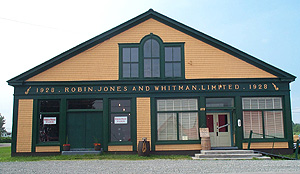 L’ANSE À BEAUFILS HISTORIC GENERAL STORE
L’ANSE À BEAUFILS HISTORIC GENERAL STORE
Until the collapse of Quebec’s cod stocks in the 1990s, this harbour south-west of Percé still bustled with the sights and smells of a traditional fishermen’s wharf. Drying racks no longer line the beach, but vestiges of life in a typical Gaspé fishing community are preserved at the old Robin, Jones and Whitman general store (1928), now a private museum. Buildings such as these were once a fixture in villages up and down the Gaspé peninsula.
Magasin Général Historique Authentique
32 rue Bonfils, L’Anse à Beaufils
(418) 782-2225 or 782-5286
PERCÉ (pop. 3,700)
Gaspé’s most famous natural attraction, Percé Rock, attracts visitors from all over the world. Amenities include several fine restaurants, an attractive seaside boardwalk and a wide range of hotels.
Early attempts at settlement here date to the 1600s when seasonal fisheries were established on Chaleur Bay under the French regime. After France ceded Canada to Britain in 1763, Charles Robin and fellow Jerseymen, John and David Le Boutillier each built fishing stations.
The distinctive wooden fish-packing shed near the government wharf is a striking relic of Percé’s early fishing heritage. Quebec park authorities maintain an excellent permanent exhibit on the bottom floor devoted to Gaspé’s traditional cod fishery and Percé’s natural history.
In the 1800s, a number of families from Ireland, Quebec and the Channel Islands joined the local fishery, settling on Bonaventure Island. Visits to the island can be arranged through local tour-boat companies. The names of many Channel Island families who settled in the area can also be found in the cemetery of St. Paul’s Anglican Church on the hilltop road to nearby Irishtown.
This guide is presented by the Quebec Anglophone Heritage Network. The Heritage Trail series is made possible by funding from the Department of Canadian Heritage and Economic Development Canada. Space constraints preclude mention of all possible sites. Thanks to Mary Robertson of the Cascapedia River Museum and to Betty Le Maistre and David Freeman for their help. For more information call the QAHN office at (819) 564-9595; toll free within Quebec at 1 (877) 964-0409.![]()
![]()